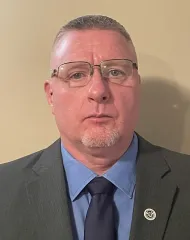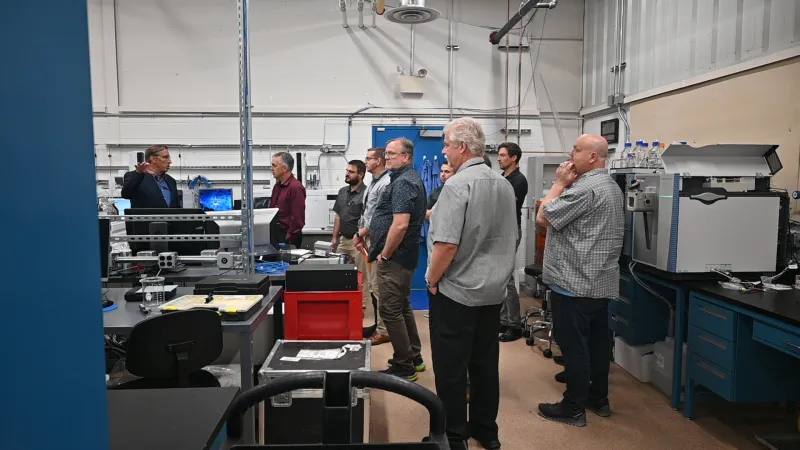Guest blog post from Timothy Herd, DOE Lab Utilization Manager, S&T Office of National Laboratories

August 19 is National Aviation Day, a day to celebrate the remarkable advancements in aviation technology pioneered more than 100 years ago, from the ingenuity of the Wright brothers—Wilbur and Orville. For us in the Science and Technology (S&T) Directorate, it is also a cause to celebrate the gains made in transportation security that have made air travel safer and more seamless. Laboratory technology has played a major role in this progress. Just like Orville had a partner in Wilbur to help create the plane, ensuring air safety is a team effort. In the spirit of this day, we highlight the integration and collaboration between S&T’s Transportation Security Laboratory (TSL) and the Department of Energy's (DOE) Pacific Northwest National Laboratory (PNNL). Working together, they have played an indispensable role in making air travel safer for all of us.
The TSL, based in Atlantic City, New Jersey, is an in-house capability for DHS, providing research, development, test and evaluation support to advance transportation security technologies. PNNL, based in Richland, Washington, is renowned for its facility-based capabilities and ability to innovate in big ways. Both labs frequently collaborate with industry partners, other government agencies, and, notably, other laboratories to develop and evaluate technologies used to protect air travelers.
A Legacy of Collaboration
Safer aviation through transportation security is an enduring priority for DHS. The tragic events of 9/11 transformed how we experience air travel forever. When Congress stood up DHS, pulling together the capabilities necessary to address the new threat landscape, laboratory science was at the forefront. Since then, the department has enjoyed a special collaborative partnership with the DOE National Laboratories to support its mission.
In 2003, PNNL invented a millimeter wave whole-body scanner developed in collaboration with TSL and ultimately licensed for security applications. DHS leveraged the technology for better screening at airports, which matured into the whole-body scanning systems that we see today. Since 2011, whole-body scanning security systems based on this technology have been in use at airports nationwide and have been deployed around the world.
Together, PNNL and TSL have developed state-of-the-art screening systems that use advanced detection techniques to identify potential threats quickly and accurately. If you have ever been to a major U.S. airport, there is a good chance you’ve walked through one of PNNL’s full body scanners that was tested and evaluated at TSL. In fact, TSL evaluates every detection technology that is ultimately deployed to U.S. airports and some international airports. The results of their work, with over 20 years of collaborating, has increased airport safety, improved the passenger experience and set a global standard for airport screening technology.

The labs also collaborated while working with S&T’s Screening at Speed (SaS) Program, which received the Federal Laboratory Consortium’s (FLC) 2022 Interagency Partnership Award. Both TSL and PNNL were honored as part of the effort for their collaborative work with SaS to develop and commercialize the High Definition-Advanced Imaging Technology (HD-AIT) and Shoe Scanner systems for air travelers, and related interagency efforts to develop and commercialize these technologies.
The work does not stop at just airports, TSL and PNNL are developing and testing promising technologies that can increase the safety and security of large venues. These advancements in screening are multifaceted and will not only keep people safer at large venues, but also continue to streamline the security process at airports to decrease wait times, while maintaining high safety standards.
This past month, a group of experts from PNNL, including its director of Homeland Security Programs, traveled to TSL for an in-person visit that was in the spirit of integration through collaboration. Several of PNNL’s technologies were on-hand to be evaluated. It was an opportunity for TSL experts to show their colleagues from Richland the facilities and rigor used to evaluate PNNL’s next generation technologies and other sophisticated detection systems and analytical tools. It was also an opportunity for PNNL and TSL to further explore ways they can strengthen their partnership in areas such as cloud computing and algorithm refinement.
“It was wonderful to see the different modalities of technologies that TSL has here that they are testing and evaluating. They are looking at those opportunities for partnership not only in the areas that we’re currently testing, but also other areas like algorithm development and machine learning.”
– Ryan Eddy, Director of Homeland Security Programs for PNNL
More Integration
S&T plays a vital role in making lab-based expertise and technology available to support DHS components’ missions. Through my office, S&T coordinates an integrated network of lab capabilities that feature TSL and our other in-house labs, as well as access to DOE’s labs such as PNNL, which together support the Department’s many mission needs. Deeper insights and greater efficiencies are more likely to surface when these labs work together in an integrated way, which we encourage as part of S&T’s mission. We provide labs with opportunities for deeper integration through events like this year’s DHS RDT&E Summit. We also execute a subject matter exchange program, now in its second year, which encourages DHS and DOE labs to exchange experts for a period of time to enhance lab-based partnerships.
National Aviation Day is a tribute to the visionaries and innovators who have propelled aviation forward. With the coordinated innovations of labs like TSL and PNNL, the skies are that much safer.
